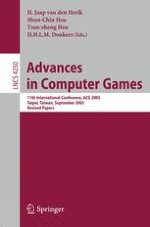2006 | Book
Advances in Computer Games
11th International Conference, ACG 2005, Taipei, Taiwan, September 6-9, 2005. Revised Papers
Editors: H. Jaap van den Herik, Shun-Chin Hsu, Tsan-sheng Hsu, H. H. L. M. (Jeroen) Donkers
Publisher: Springer Berlin Heidelberg
Book Series : Lecture Notes in Computer Science
